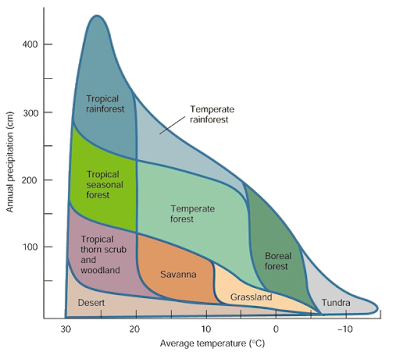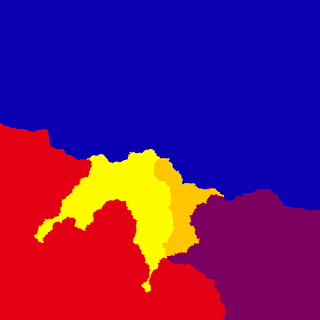In the
previous post, I introduced our new land mass generation system. Let's take a look at how it works.
For such a large thing like a continent, I knew we would need some kind of global generation method. Global methods involve more than just the point of space you are generating. The properties for a given point are influenced by points potentially very far away. Global methods, like simulations, may require you to perform multiple iterations over the entire dataset. I favor global methods for anything larger than a coffee stain in your procedural table cloth. The reason is they can produce information whereas local methods cannot: information is limited to the seeds used in the local functions.
The problem in using a global simulation is speed. Picking the right evaluation structure is paramount. I wanted to produce maps of approximately 2000x2000 pixels, where each pixel would cover around 2 km. I wanted this process to run in less than five seconds for a single CPU thread. Running the generation algorithm over pixels would not get me there.
The alternative to simulating on a discrete grid (pixels) is to use a graph of interconnected points. A good approach here is to scatter points over the map, compute the Voronoi cells for them, and use the cells and their dual triangulation as the scaffolding for the simulation.
I had tried this in the past with fairly good results, but there was something about it that did not sit well with me. In order to have pleasant results, the Voronoi cells must be relaxed so they become similarly shaped and the dual triangulation is made of regular triangles.
If the goal was to produce a fairly uneven but still regular triangle mesh, why not just start there and avoid the expensive Voronoi generaion phase? We would still have implicit Voronoi cells because they are dual to the mesh.
We started from the most regular mesh possible, an evenly tessellated plane. While doing so we made sure all diagonal edges would not go in the same direction by making their orientation flip randomly:
Getting the organic feel of the Voronoi driven meshes from here was simple. Each triangle is assigned a weight and all vertices are pulled or pushed into triangles depending on these weights. After repeating the process a few times you get something that looks like this:
This is already very close to what you would get from the relaxed Voronoi phase. The rest of the generation process operates over the vertices in this mesh and transfers information from one point to another using the edges connecting vertices.
With the simulation scafolding ready, the first actual step into creating the land mass is to define its boundaries. The system allows a user to input a shape, in case you were looking for that heart-shaped continent, but if no shape is provided a simple multiresolution fractal is used. This is a fairly simple stage, where vertices are classified as "in" or "out". The result is the continent shoreline:
Once we have this, we can compute a very important bit of information that will be used over and over later during the generation: the distance to shoreline. This is fairly quick to to compute thanks to the fact we operate in mesh space. For those triangle edges that cross the shoreline we set the distance to zero, for edges connected into these the distance is +1 and so on. It is trivial to produce a signed distance if you add for edges in mainland and subtract for edges in the ocean.
It is time to add some mountain ranges. A naive approach would be to use distance to shore to raise the ground, but this would be very unrealistic. If you look at some of the most spectacular mountain ranges on Earth, they happen pretty close to coast lines. What is going on there?
It is the interaction of plate tectonics what has produced most of the mountain ranges that have captured our imagination. This process is called orogeny, and there are basically two flavors of it, accounting for most mountains on Earth. The first is when two plates collide and raise the ground. This is what gave us the Himalayas. The second is when the oceanic crust (which is a thinner New-York-pizza-style crust) sinks below the thicker continental crust. This raises the continental crust producing mountains like the Rockies and the Andes. The two processes are necessary if you look for a desirable distribution of mountains in your synthetic world.
Since we already have the shape of the continental land, it is safe to assume this is part of a plate that originated some time before. More-so, we can assume we are looking at more than one continental plate. This is what you see when you look at northern India, even if it is all a single land mass, three plates meet at this point: the Arabian, Indian and Eurasian plates.
Picking points fairly inland, we can create fault lines going from these points into the map edge. Again this works in mesh space, so it is fairly quick and the results have the rugged nature we initially imprinted into the mesh:
Contrary to what you may think, this is not a pathfinding algorithm. This is your good-old midpoint displacement in action. We start with a single segment spanning from the fault source to the edge of the map. This segment, and each subsequent segment, is refined by adding a point in the middle. This point is shifted along a vector perpendicular to the segment by a random amount. It is fairly quick to know which triangles are crossed by the segments so the fault can be incorporated into the simulation mesh.
In this particular case the operation has created three main plates, but we are still missing the oceanic plates. These occur a bit randomly, as not every shoreline corresponds to an oceanic plate. We simulated their occurrence by doing vertex flood fills on selective corners of the map. Here you can see the final set of plates for the continent:
The mere existence of plates is not enough to create mountain ranges. They have to move and collide. To each plate we assign a movement vector. This encodes not only the direction, but also the speed at which the plate is moving:
Based on these vectors we can compute the pressure on each vertex and decide how much it should be raised or lowered, resulting in the base elevation map for the continent:
All the mountains happened to occur in the South side of the continent. You can see why this was determined by the blue plate drifting away from the mainland, otherwise we would have had a very different outcome. This will be an interesting place anyway. While the gray-scale image does not show it, the ground where the blue plate begins sinks considerably, creating a massive continent-wide ravine.
Getting the continent shape and mountain ranges is only half the story. Next comes how temperature, humidity and finally biomes are computed. Stay close for part two!




















































